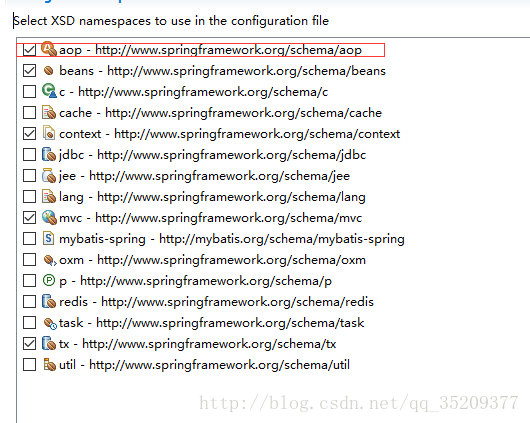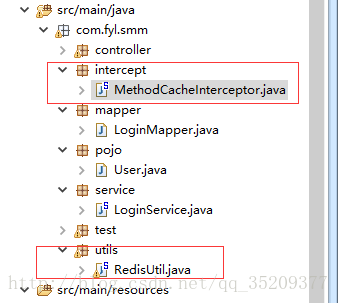学习之旅(二)(ssm框架加入redis)
ssm框架加入简单的redis缓存
1.在src/mian/resources下加入redis.properties
#redis中心
redis.host=localhost
redis.port=6379
redis.password=
redis.maxIdle=100
redis.maxActive=300
redis.maxWait=1000
redis.testOnBorrow=true
redis.timeout=100000
# 不需要加入缓存的类
targetNames=
# 不需要缓存的方法
methodNames=
#设置缓存失效时间
com.service.impl.xxxRecordManager=60
com.service.impl.xxxSetRecordManager=60
defaultCacheExpireTime=3600
fep.local.cache.capacity=100002.在spring-mybatis.xml中添加redis的配置
(1)勾选aop

(2)引入配置文件修改成引入多个的list
<bean id="propertyConfigurer"
class="org.springframework.beans.factory.config.PropertyPlaceholderConfigurer">
<property name="locations">
<list>
<value>classpath:jdbc.propertiesvalue>
<value>classpath:redis.propertiesvalue>
list>
property>
bean> (3)添加redis配置和aop
<bean id="poolConfig" class="redis.clients.jedis.JedisPoolConfig">
<property name="maxIdle" value="${redis.maxIdle}"/>
<property name="maxWaitMillis" value="${redis.maxWait}"/>
<property name="testOnBorrow" value="${redis.testOnBorrow}"/>
bean>
<bean id="connectionFactory" class="org.springframework.data.redis.connection.jedis.JedisConnectionFactory">
<property name="poolConfig" ref="poolConfig"/>
<property name="port" value="${redis.port}"/>
<property name="hostName" value="${redis.host}"/>
<property name="timeout" value="${redis.timeout}">property>
bean>
<bean id="redisTemplate" class="org.springframework.data.redis.core.RedisTemplate">
<property name="connectionFactory" ref="connectionFactory"/>
<property name="keySerializer">
<bean class="org.springframework.data.redis.serializer.StringRedisSerializer"/>
property>
<property name="valueSerializer">
<bean class="org.springframework.data.redis.serializer.JdkSerializationRedisSerializer"/>
property>
bean>
<bean id="methodCacheInterceptor" class="com.fyl.smm.intercept.MethodCacheInterceptor">
<property name="redisUtil" ref="redisUtil"/>
bean>
<bean id="redisUtil" class="com.fyl.smm.utils.RedisUtil">
<property name="redisTemplate" ref="redisTemplate"/>
bean>
<aop:config proxy-target-class="true">
<aop:pointcut id="controllerMethodPointcut" expression="
execution(* com.fyl.smm.service.*.get*(..))"/>
<aop:pointcut id="selectMethodPointcut" expression="
execution(* com.fyl.smm.mapper.*Mapper.get*(..))"/>
<aop:advisor advice-ref="methodCacheInterceptor" pointcut-ref="controllerMethodPointcut"/>
aop:config>3.添加一个工具类和一个aop的拦截器类

(1)MethodCacheInterceptor.java
package com.fyl.smm.intercept;
import java.util.ArrayList;
import java.util.List;
import org.aopalliance.intercept.MethodInterceptor;
import org.aopalliance.intercept.MethodInvocation;
import org.slf4j.Logger;
import org.slf4j.LoggerFactory;
import com.fyl.smm.utils.RedisUtil;
public class MethodCacheInterceptor implements MethodInterceptor {
private Logger logger = LoggerFactory.getLogger(MethodCacheInterceptor.class);
private RedisUtil redisUtil;
private List targetNamesList; // 不加入缓存的service名称
private List methodNamesList; // 不加入缓存的方法名称
private Long defaultCacheExpireTime; // 缓存默认的过期时间
private Long xxxRecordManagerTime; //
private Long xxxSetRecordManagerTime; //
/**
* 初始化读取不需要加入缓存的类名和方法名称
*/
public MethodCacheInterceptor() {
try {
// 分割字符串 这里没有加入任何方法
String[] targetNames = {};
String[] methodNames = {};
// 加载过期时间设置
defaultCacheExpireTime = 3600L;
xxxRecordManagerTime = 60L;
xxxSetRecordManagerTime = 60L;
// 创建list
targetNamesList = new ArrayList(targetNames.length);
methodNamesList = new ArrayList(methodNames.length);
Integer maxLen = targetNames.length > methodNames.length ? targetNames.length
: methodNames.length;
// 将不需要缓存的类名和方法名添加到list中
for (int i = 0; i < maxLen; i++) {
if (i < targetNames.length) {
targetNamesList.add(targetNames[i]);
}
if (i < methodNames.length) {
methodNamesList.add(methodNames[i]);
}
}
} catch (Exception e) {
e.printStackTrace();
}
}
@Override
public Object invoke(MethodInvocation invocation) throws Throwable {
Object value = null;
String targetName = invocation.getThis().getClass().getName();
String methodName = invocation.getMethod().getName();
// 不需要缓存的内容
//if (!isAddCache(StringUtil.subStrForLastDot(targetName), methodName)) {
if (!isAddCache(targetName, methodName)) {
// 执行方法返回结果
return invocation.proceed();
}
Object[] arguments = invocation.getArguments();
String key = getCacheKey(targetName, methodName, arguments);
logger.debug("redisKey: " + key);
try {
// 判断是否有缓存
if (redisUtil.exists(key)) {
return redisUtil.get(key);
}
// 写入缓存
value = invocation.proceed();
if (value != null) {
final String tkey = key;
final Object tvalue = value;
new Thread(new Runnable() {
@Override
public void run() {
if (tkey.startsWith("com.service.impl.xxxRecordManager")) {
redisUtil.set(tkey, tvalue, xxxRecordManagerTime);
} else if (tkey.startsWith("com.service.impl.xxxSetRecordManager")) {
redisUtil.set(tkey, tvalue, xxxSetRecordManagerTime);
} else {
redisUtil.set(tkey, tvalue, defaultCacheExpireTime);
}
}
}).start();
}
} catch (Exception e) {
e.printStackTrace();
if (value == null) {
return invocation.proceed();
}
}
return value;
}
/**
* 是否加入缓存
*
* @return
*/
private boolean isAddCache(String targetName, String methodName) {
boolean flag = true;
if (targetNamesList.contains(targetName)
|| methodNamesList.contains(methodName)) {
flag = false;
}
return flag;
}
/**
* 创建缓存key
*
* @param targetName
* @param methodName
* @param arguments
*/
private String getCacheKey(String targetName, String methodName,
Object[] arguments) {
StringBuffer sbu = new StringBuffer();
sbu.append(targetName).append("_").append(methodName);
if ((arguments != null) && (arguments.length != 0)) {
for (int i = 0; i < arguments.length; i++) {
sbu.append("_").append(arguments[i]);
}
}
return sbu.toString();
}
public void setRedisUtil(RedisUtil redisUtil) {
this.redisUtil = redisUtil;
}
}
(2)RedisUtil.java
package com.fyl.smm.utils;
import java.io.Serializable;
import java.util.Set;
import java.util.concurrent.TimeUnit;
import org.apache.log4j.Logger;
import org.springframework.data.redis.core.RedisTemplate;
import org.springframework.data.redis.core.ValueOperations;
public class RedisUtil {
private Logger logger = Logger.getLogger(RedisUtil.class);
private RedisTemplate redisTemplate;
/**
* 批量删除对应的value
*
* @param keys
*/
public void remove(final String... keys) {
for (String key : keys) {
remove(key);
}
}
/**
* 批量删除key
*
* @param pattern
*/
public void removePattern(final String pattern) {
Set keys = redisTemplate.keys(pattern);
if (keys.size() > 0)
redisTemplate.delete(keys);
}
/**
* 删除对应的value
*
* @param key
*/
public void remove(final String key) {
if (exists(key)) {
redisTemplate.delete(key);
}
}
/**
* 判断缓存中是否有对应的value
*
* @param key
* @return
*/
public boolean exists(final String key) {
return redisTemplate.hasKey(key);
}
/**
* 读取缓存
*
* @param key
* @return
*/
public Object get(final String key) {
Object result = null;
ValueOperations operations = redisTemplate
.opsForValue();
result = operations.get(key);
return result;
}
/**
* 写入缓存
*
* @param key
* @param value
* @return
*/
public boolean set(final String key, Object value) {
boolean result = false;
try {
ValueOperations operations = redisTemplate
.opsForValue();
operations.set(key, value);
result = true;
} catch (Exception e) {
e.printStackTrace();
}
return result;
}
/**
* 写入缓存
*
* @param key
* @param value
* @return
*/
public boolean set(final String key, Object value, Long expireTime) {
boolean result = false;
try {
ValueOperations operations = redisTemplate
.opsForValue();
operations.set(key, value);
redisTemplate.expire(key, expireTime, TimeUnit.SECONDS);
result = true;
} catch (Exception e) {
e.printStackTrace();
}
return result;
}
public void setRedisTemplate(
RedisTemplate redisTemplate) {
this.redisTemplate = redisTemplate;
}
}
4.pom.xml中添加需要的类
<dependency>
<groupId>redis.clientsgroupId>
<artifactId>jedisartifactId>
<version>2.9.0version>
dependency>
<dependency>
<groupId>org.springframework.datagroupId>
<artifactId>spring-data-redisartifactId>
<version>1.6.1.RELEASEversion>
dependency>
<dependency>
<groupId>org.aspectjgroupId>
<artifactId>aspectjweaverartifactId>
<version>1.8.4version>
dependency>在搭建中遇到一个问题,要给加入redis缓存的pojo类实现Serializable接口
主要的搭建还是参照大神的文章,给出连接地址http://blog.csdn.net/qq_18661793/article/details/53719161